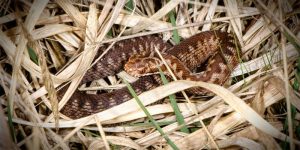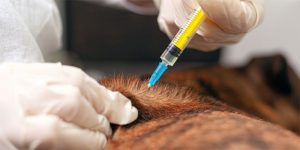Adder Bites In Dogs.
This Holidays4Dogs article considers the possible dangers of adder snake bites to dogs. Thankfully, snake bites are not terribly common, but it is nevertheless important for owners to be aware of potential dangers – particularly over the spring and summer months during adder mating season.
Adders are the only venomous snake in the U.K. However, adders are not aggressive and only bite if disturbed, or picked up. There have been just 14 deaths of people from adder bites in the past 145 years – so exceptionally rare. Similarly, it is uncommon for dogs to die of adder bites and most dogs that suffer a bite, will make a full recovery.
What is the Adder’s habitat and what do they look like?
Adders are prevalent in the English countryside from March to October. They live in woodland, moorland and heathland habitats where many people like to walk their dogs. In 2022, Staffordshire bull terrier Sam, was bitten by an adder while walking with his owners in Gower, Wales. Thankfully, with extensive treatment the dog survived.
During the first warm days of March, adders emerge from hibernation. This is when these distinctive snakes can often be spotted, basking in the sunshine.
In the Springtime, male adders perform ‘dances’ as a means of competing with other males during the mating season.
Adders are pretty distinctive having an obvious zig-zag pattern down their backs. Male adders are silver-grey and females are more reddish-brown.
Some individuals are completely black. Adders reside in areas across the length and breadth of the UK. excluding the Isle of Man, Scilly Isles, Channel Islands or, Northern Ireland.
How common are adder bites in dogs?
Thankfully, adder bites in dogs are not common. Indeed, adders are declining in numbers rapidly. If this trend continues there will only be a handful of areas in the UK, where adders thrive. However, the danger periods are during the spring and summer months when adders are waking from hibernation and are at their most active. Adders will only bite in self defence when disturbed, or stepped on.
Signs of adder bites in dogs.
Most snake bites occur around the head, or leg area. It may be possible to see signs of two small puncture wounds in the centre of the swelling. It is important to be aware that swelling around the face and neck area can result in breathing difficulties. This can occur due to the bodies reaction to toxins and the dog will need urgent treatment.
Your dog may show signs of distress and he may salivate, or vomit. Other symptoms include restlessness and drowsiness. In more severe cases, the dog may collapse and develop blood clotting problems. This is a particular concern in some dogs where the bite has gone un-noticed, or treatment has been delayed.
Adder bite treatment.
If you think your dog may have been bitten by a snake, seek veterinary assistance as soon as possible. It is preferable to carry your dog, as allowing him to walk may cause the venom to travel more quickly around the bloodstream.
by a snake, seek veterinary assistance as soon as possible. It is preferable to carry your dog, as allowing him to walk may cause the venom to travel more quickly around the bloodstream.
Keep the dog warm and, if possible, bathe the wound in cool water to help keep the swelling down.
Your vet will treat your dog with pain killers and will deal with any shock, or swelling. For adder bites, it is important to support the dog’s circulation and organ function.
Presently, there is no anti-venom treatment in the UK which is authorised for animal use. However, in some emergency cases, it can be administered if the vet obtains a Special Treatment Certificate. Few vets stock vials of anti-venom and the cost of treating an animal can be very expensive.
Conclusion.
While adder bites in dogs are relatively rare in the UK, it is always worth being aware of the snake habitats and symptoms of bites. Keep to designated footpaths and make sure your dog stays close to you. Avoid allowing your dog to forage in the undergrowth where adders may be lurking. This is most important during the spring and summer months.


